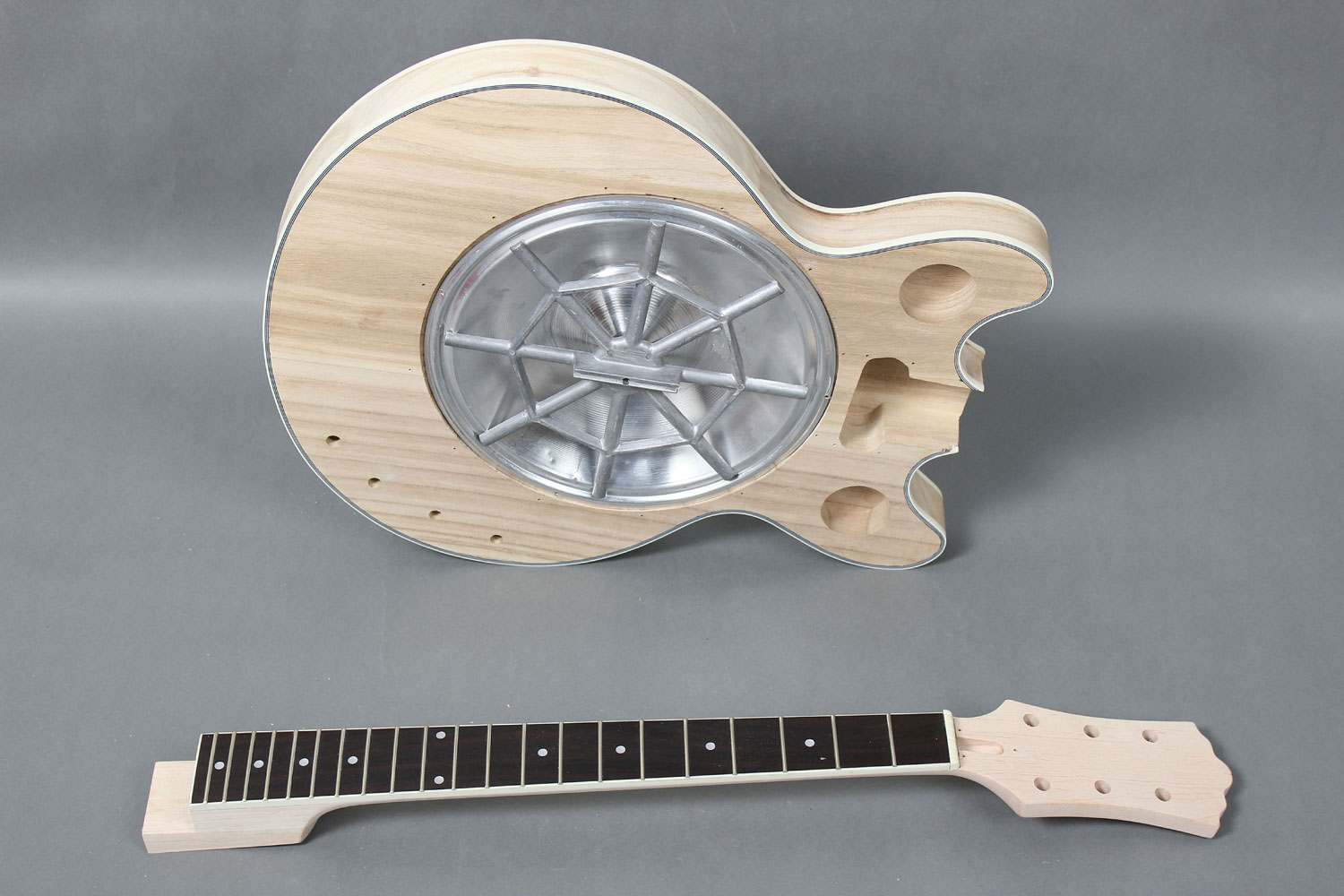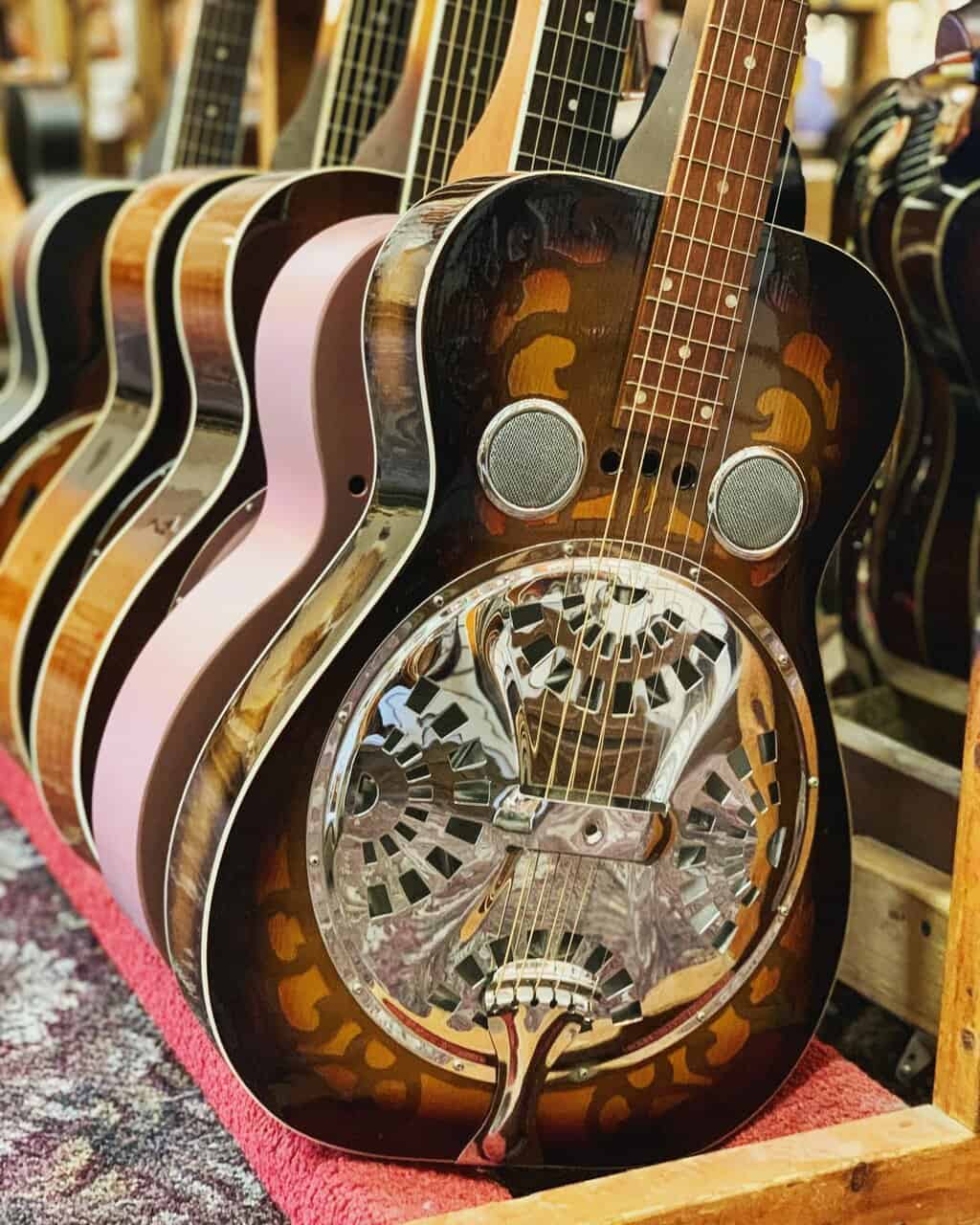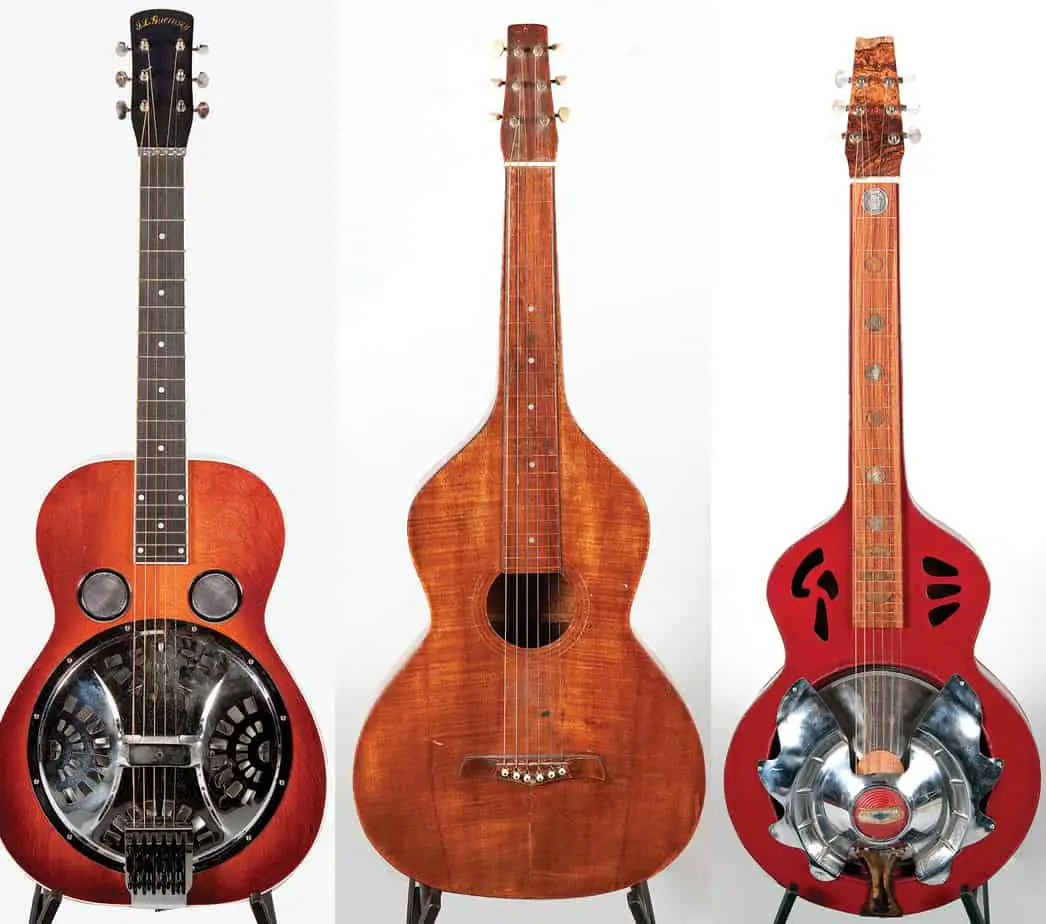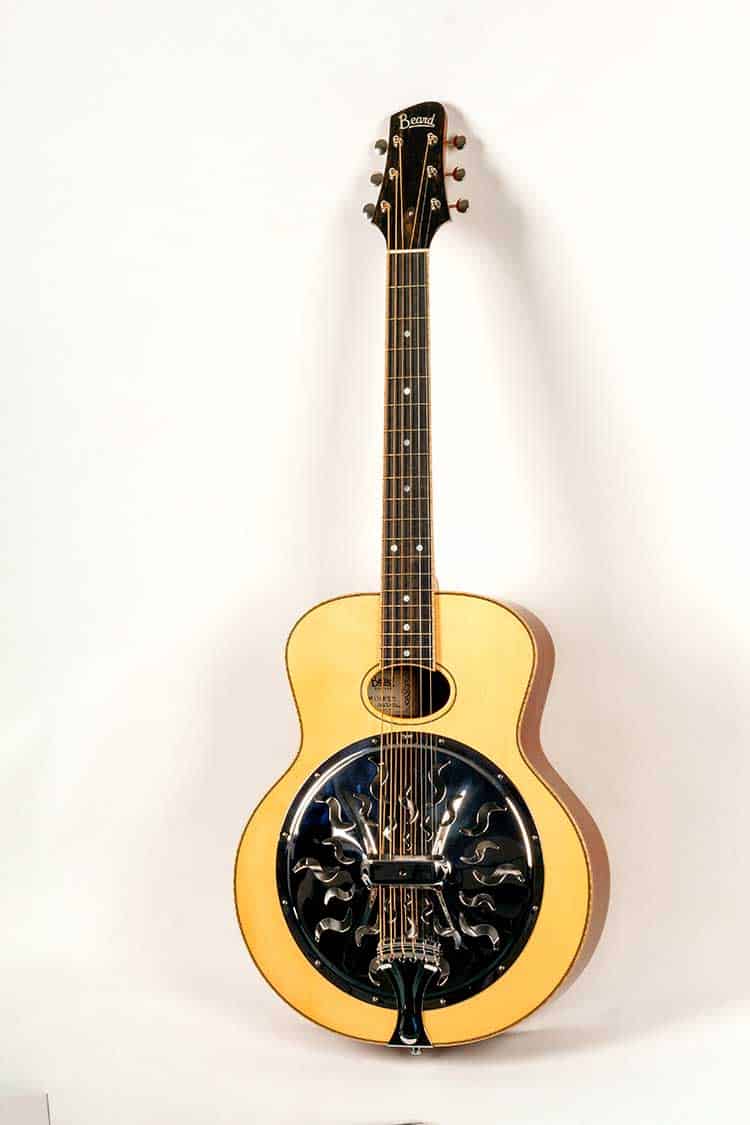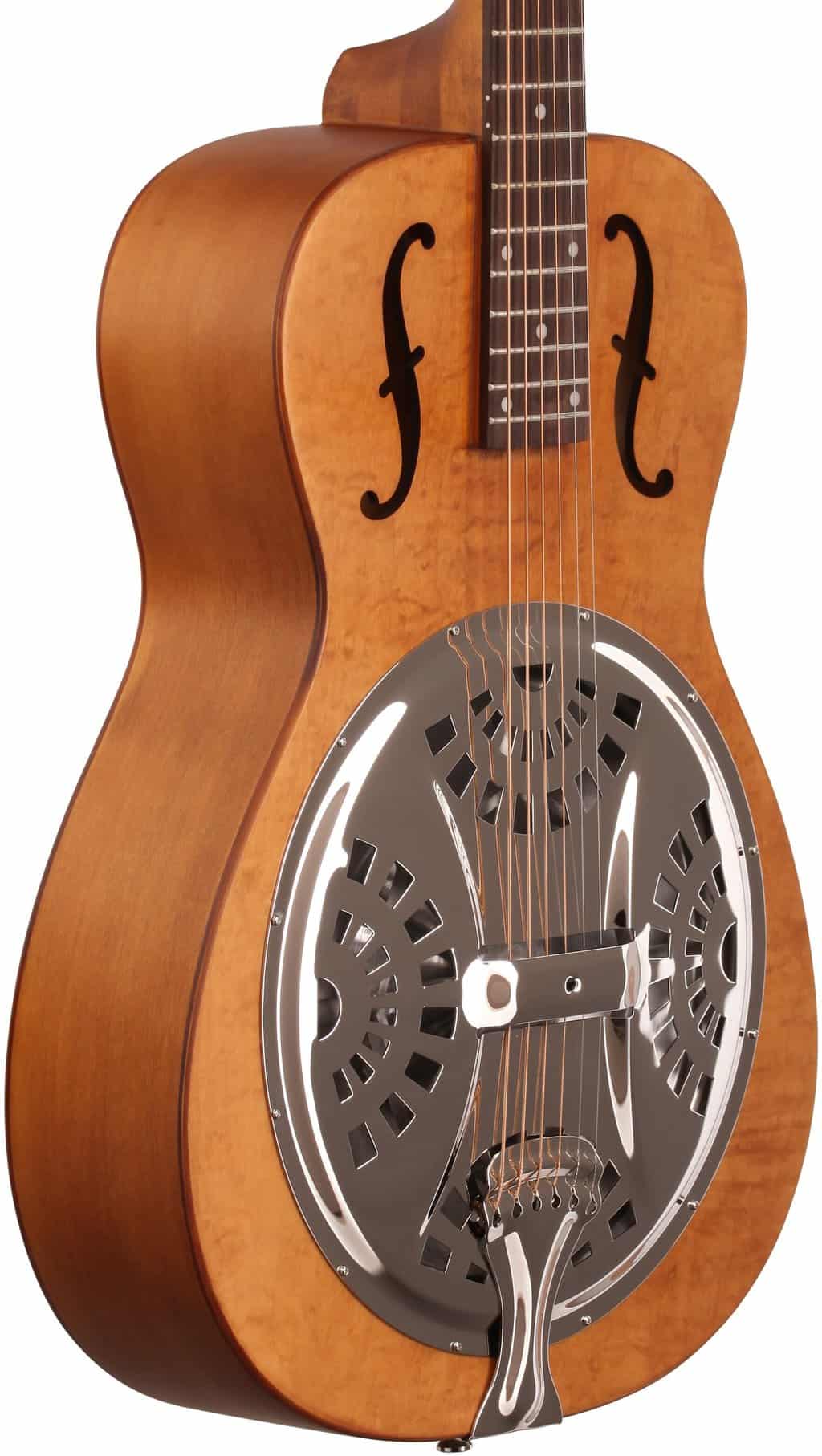Have you ever heard an instrument that sounds like a mix between a banjo and a guitar? If so, chances are it was a dobro resonator guitar. This unique instrument has a distinctive sound that comes from its metal resonator, which gives it a bright and powerful tone. In this article, I’ll explain what a dobro resonator guitar is and the basics of how to play one.
History of the Dobro Resonator Guitar
| Year | Event |
|---|---|
| 1920 | John Dopyera and his brothers, Rudy, Eddie and Robert, founded the National and Dobro Manufacturing Company in Los Angeles. |
| 1930 | John Dopyera resigned from National and Dobro Manufacturing Company and formed a new company, the Dobro Corporation of America. |
| 1935 | Dobro Corporation of America introduces the first resonator guitar with a metal body, the Dobro Model 75. |
| 1947 | Dobro Corporation of America is purchased by Valco, a Chicago-based musical instrument manufacturing company. |
| 1949 | Valco introduces the Dobro Model 60, the first resonator guitar with a wooden body. |
| 1970s | Dobro resonator guitars become popular with country and bluegrass musicians who appreciate their distinctive sound. |
| 2006 | Gibson acquires Dobro and the rights to the Dobro name. |
Dobro resonator guitars, also known as “resophonic guitars,” are an iconic type of guitar that was first developed in the early 1920s. The Dobro resonator guitar was invented by John Dopyera, a Slovakian immigrant who founded the National and Dobro Manufacturing Company in Los Angeles in 1920. In 1930, Dopyera resigned from the company and formed the Dobro Corporation of America, which introduced the first resonator guitar with a metal body, the Dobro Model 75, in 1935.
In 1947, the Dobro Corporation of America was purchased by Valco, a Chicago-based musical instrument manufacturing company. Valco then introduced the Dobro Model 60, the first resonator guitar with a wooden body, in 1949. During the 1970s, Dobro resonator guitars became popular with country and bluegrass musicians who appreciated the instrument’s distinctive sound.
In 2006, Gibson acquired Dobro and the rights to the Dobro name. Today, Dobro resonator guitars are some of the most popular and iconic instruments in the world.
Construction of the Dobro Resonator Guitar
The Dobro resonator guitar is a type of acoustic guitar that produces a distinctively bright sound due to its metal resonator cone in the center of the soundboard. The resonator cone is made of aluminium and is designed to move the soundwaves from the strings in a different direction, resulting in a bright, powerful sound. The Dobro resonator guitar has a single-cone design that creates a deep, full-bodied sound.
The Dobro resonator guitar has a distinctive shape and construction compared to a traditional acoustic guitar. The body is typically round and slightly smaller than a standard acoustic guitar while the neck is often longer. The headstock is mounted to the neck and holds the tuning machines. The bridge and tailpiece are made of metal, and the strings run through the bridge and over the cone, known as a “spider”, to the tailpiece. The body of the guitar is made of wood and is typically made of mahogany. The soundboard is made of spruce and is usually arched to give the guitar a distinct tone.
The Dobro resonator guitar is usually fitted with a metal pickguard to protect the guitar’s soundboard from damage due to the metal resonator. The pickguard helps create a unique tone by helping to reflect the sound off the resonator cone. The Dobro resonator guitar is typically played with a flatpick but can also be fingerpicked or strummed with a pick or bare fingers.
The Dobro resonator guitar is a unique type of acoustic guitar that produces a bright and powerful sound. Its distinct construction and metal resonator cone make it a popular choice among bluegrass and folk musicians, and its unique sound has made it a favorite among guitarists of all genres.
How the Dobro Resonator Guitar Works
The Dobro Resonator guitar is a type of guitar that produces its sound from a metal resonator cone instead of from the strings. It produces a loud, ringing sound that is distinctive of the blues and bluegrass genres. The resonator cone is made of spun metal and is typically connected to the guitar at the bridge and tailpiece.
The resonator cone works by amplifying the vibrations of the strings and projecting them back out into the air. The cone is designed to vibrate in a certain way and to a certain frequency, creating a unique sound. The material and thickness of the cone, as well as the shape, size, and number of its openings, all affect the sound.
The resonator cone is connected to the guitar by a bridge and tailpiece. The bridge has a movable saddle that the strings rest on. The bridge is connected to the cone, allowing the strings to interact with the cone when they are plucked. The tailpiece is a metal plate that holds the strings in place.
The metal resonator cone is a key element of the Dobro Resonator guitar. It amplifies the sound of the strings and projects it outward, creating a unique sound that is distinctive of the style. The shape, size, material, and number of openings in the cone all affect the sound. The bridge and tailpiece also play an important role in creating the sound of the guitar.
Popular Music Genres Featuring the Dobro Resonator Guitar
The Dobro resonator guitar is a type of guitar that has a metal resonator cone and a round neck. It has become a popular instrument in a variety of genres, including country, bluegrass, folk and blues. Here are some of the most popular music genres featuring the Dobro resonator guitar:
| Genre | Description |
|---|---|
| Country | Country music often features the Dobro resonator guitar. It is often used as a lead instrument in solos, as well as for accompaniment. |
| Bluegrass | The Dobro resonator guitar is a staple of bluegrass music. It is used to add texture and color to the sound of the band. |
| Folk | The Dobro resonator guitar is a popular instrument in folk music. It is used to provide a unique sound, often to accompany a singer. |
| Blues | The Dobro resonator guitar has been used in blues music for decades. It is often used to add a unique sound to the traditional blues sound. |
The Dobro resonator guitar is a versatile instrument that can be used in a variety of genres. From country to bluegrass to folk and blues, the Dobro resonator guitar can provide a unique sound to any genre.
Famous Artists Who Have Used the Dobro Resonator Guitar
| Artist | Genre |
|---|---|
| Roy Acuff | Country |
| Bob Dylan | Folk Rock |
| Jerry Garcia | Rock/Folk |
| John Hartford | Folk/Bluegrass |
| Doc Watson | Bluegrass/Folk |
| Robbie Robertson | Rock/Folk |
| John Sebastian | Folk/Rock |
| Bruce Springsteen | Rock/Folk |
| Earl Scruggs | Bluegrass/Country |
| Neil Young | Folk Rock/Rock |
The Dobro Resonator Guitar has been used by many famous musicians throughout the years. Roy Acuff, Bob Dylan, Jerry Garcia, John Hartford, Doc Watson, Robbie Robertson, John Sebastian, Bruce Springsteen, Earl Scruggs, and Neil Young are just a few of the many artists who have used a Dobro Resonator Guitar. These musicians span a wide range of genres including Country, Folk Rock, Bluegrass, and Rock.
Styles of Playing the Dobro Resonator Guitar
- Bluegrass – This style is characterized by fast and intricate picking patterns and improvisation.
- Country – Country music is often comprised of melodic picking and strumming patterns with a few embellishments thrown in for good measure.
- Blues – Dobro resonator guitars are well-suited to blues music. This style of playing relies heavily on bottleneck slides and chordal riffs.
- Celtic – Celtic music is often played with a mix of fingerpicking and strumming.
- Gospel – Gospel music typically relies on the use of a Dobro resonator guitar to provide a strong and powerful accompaniment.
- Folk – Folk music often uses a variety of picking patterns to provide a melodic sound.
- Jazz – Jazz is a style of music that favors improvisation and complex chord voicings.
Maintenance of the Dobro Resonator Guitar
The Dobro resonator guitar is a unique instrument that requires special maintenance. The key to maintaining a Dobro resonator guitar is regular inspection and cleaning. A few basic maintenance steps should be done every time the guitar is played. Here are some tips for maintaining your Dobro resonator guitar:
| Task | Procedure |
| String Inspection | Check the strings for signs of wear and tear, such as fraying or kinking. If the strings show any sign of wear, they should be replaced. |
| Fingerboard Cleaning | Use a soft cloth to wipe down the fingerboard and remove any dirt or grime. If necessary, use a cleaning solution specifically designed for guitars. |
| Polish | Apply a small amount of guitar polish to the body of the instrument and rub gently in a circular motion. Be sure to avoid any crevices or tight spots that could trap polish. |
| Tuning | Tune the guitar using a tuning device such as an electronic tuner or an app. Adjust the tuning pegs until the strings are in tune. |
| Wax | Apply a thin coat of guitar wax to the metal parts of the instrument, such as the cone and the tailpiece. This will help keep the metal parts shiny and rust-free. |
By following these steps, your Dobro resonator guitar will remain in excellent condition for many years of playing.
Accessories for the Dobro Resonator Guitar
| Accessories | Description |
|---|---|
| Slide | A smooth metal or glass tube used to play the strings by pressing on them instead of plucking or strumming. |
| Pickup | A device that captures the vibrations of the strings and sends them to an amplifier. |
| Gig Bag | A bag designed to carry musical instruments and accessories. |
| Tuner | A device used to adjust the pitch of a stringed instrument. |
| Strings | Metal wires that are stretched across the resonator guitar’s neck. |
The Dobro resonator guitar requires some basic accessories for optimal performance. These include a slide, pickup, gig bag, tuner, and strings. A slide is a smooth metal or glass tube used to play the strings by pressing on them instead of plucking or strumming. A pickup is a device that captures the vibrations of the strings and sends them to an amplifier. A gig bag is a bag designed to carry musical instruments and accessories. A tuner is a device used to adjust the pitch of a stringed instrument. Finally, strings are metal wires that are stretched across the resonator guitar’s neck.
Frequently Asked Questions
What makes a dobro resonator guitar unique?
A dobro resonator guitar is a type of guitar that is distinguished by its distinctive metal “resonator” cone, located under the bridge, which amplifies the sound by sending the vibrations through the guitar body. The resonator cone, which is either spun aluminum or spun brass, is the signature feature of the dobro resonator guitar, and gives it a unique sound that is louder than an acoustic guitar and more mellow than an electric guitar. The dobro resonator guitar is also unique in that it is usually played in an upright position (vertically).
How Does a Dobro Resonator Guitar Produce Sound?
A Dobro resonator guitar produces sound through the use of a metal cone, or “resonator”, that amplifies the strings’ vibrations. The resonator fits into a wooden circular soundwell that is attached to the underside of the guitar’s bridge. The soundwell is then connected to the air inside the guitar’s body, which amplifies the sound to create a unique and rich tone. The resonator also helps the guitar to project sound further than a traditional acoustic guitar.
What types of music styles is a dobro resonator guitar typically used for?
A dobro resonator guitar is often used in genres such as bluegrass, folk, country, and blues. It is also used by some rock, jazz, and pop musicians. The dobro is often used to create a unique sound that is distinct from the traditional electric guitar. The dobro is also often used to add a unique texture to a song.
What features should I consider when choosing a dobro resonator guitar?
The main feature to consider when choosing a dobro resonator guitar is the type of resonator—metal or wooden. Metal resonators produce a bright, crisp sound, while wooden resonators produce a warmer, mellower sound. The body of the guitar should also be taken into account—dobro resonators typically come in square-neck or round-neck designs. The size and weight of the dobro should also be considered, as well as the type of strings and pickups (electronics) the guitar has. Finally, the price of the dobro resonator guitar should be compared to similar models to make sure that you are getting the best value for your money.
What are the benefits of playing a dobro resonator guitar?
Dobro resonator guitars offer a unique sound that is well-suited for blues, folk, country, and other genres. The resonator cone in the guitar’s body amplifies the sound, giving it a distinct tone. It also produces a louder sound than a regular acoustic guitar, which is great for live performance. The use of round wound strings also allows for a more powerful sound. Dobro resonator guitars are relatively easy to play, as the strings are often spaced further apart than on other guitars. Additionally, the guitar’s shape makes it comfortable to play while sitting, which is great for country and blues style playing.
Conclusion
The Dobro resonator guitar is an iconic instrument with a unique sound. Its construction and design contribute to a distinctive tonal quality that sets it apart from other guitars. The Dobro is most commonly associated with blues, bluegrass, and country music, but its versatility allows it to be used in a variety of musical genres. The Dobro has a long and storied history and its unique sound is sure to continue to be heard in the music of today.


